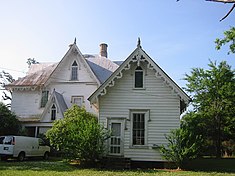Fairhope Plantation
History
Fairhope Plantation was built for Joseph Selden, a native of Virginia. He was born on June 4, 1831, and grew up at Westover Plantation in Charles City County, Virginia. Selden married Elizabeth Collier Minge, of Weynoke Plantation, Virginia, near Faunsdale, in 1854. Elizabeth was born on May 30, 1833. Her family was also originally from Charles City County. Joseph and Elizabeth established Fairhope on property given to them by Elizabeth's family. The main house was built by Theophilus Gilliam Fowler, a local builder. Construction began in 1857 and was completed by 1861. The 1860 United States census of Perry County indicates that Joseph Selden owned 80 slaves in that year. Selden organized Selden's Battery, an artillery unit, at his own expense during the American Civil War. The unit saw action in several major engagements, including the battles of Kennesaw Mountain, Franklin and Nashville. Elizabeth Selden died following childbirth in 1868, Joseph died in a hotel fire in 1900. Fairhope continued to be owned by Selden descendants and operated as a farm for another century after their deaths.
Architecture
The inspiration for the main house at Fairhope Plantation is thought by architectural historians to be an enlarged adaptation of a design by Alexander Jackson Davis, published in Andrew Jackson Downing's Cottage Residences in 1842. The house features numerous Gothic Revival details, including intricate bargeboards on the eaves and gables, hood moldings over the doors and windows, octagonal brick chimneys, and central gables topped by finials on all four sides. Additionally, it has a one-story cast-iron veranda around three sides of the ground floor. It is one of only about twenty Gothic Revival residential structures remaining in Alabama. Other historic Gothic Revival residences in the area include Waldwic in Gallion and Ashe Cottage in Demopolis.
References
- ^ "National Register Information System". National Register of Historic Places. National Park Service. July 9, 2010.
- ^ "The Alabama Register of Landmarks & Heritage" (PDF). preserveala.org. Alabama Historical Commission. February 24, 2014. Archived from the original (PDF) on April 8, 2014. Retrieved October 25, 2012.
- ^ Bailey, Will. "Joseph Selden". Rootsweb. Retrieved December 30, 2008.
- ^ "1860 United States Census - Slave schedule, Perry County, Alabama". United States Census Bureau. USGenWeb Archives. Archived from the original on May 17, 2009. Retrieved December 30, 2008.
- ^ Cooper, Chip; Harry J. Knopke; Robert S. Gamble (1993). Silent in the Land. Tuscaloosa, Alabama: CKM Press. p. 180. ISBN 0-9636713-0-8.
- ^ "Selden's-Lovelace's"-Battery". Alabama Department of Archives and History. Retrieved December 30, 2008.
- ^ Gamble, Robert Historic architecture in Alabama: a guide to styles and types, 1810–1930, pages 89-90 . Tuscaloosa, Alabama: The University of Alabama Press, 1990. ISBN 0-8173-1134-3.



